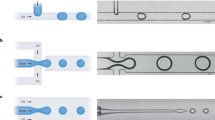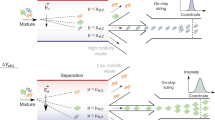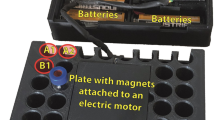Abstract
Micrometre-scale analytical devices are more attractive than their macroscale counterparts for various reasons. For example, they use smaller volumes of reagents and are therefore cheaper, quicker and less hazardous to use, and more environmentally appealing. Scaling laws compare the relative performance of a system as the dimensions of the system change, and can predict the operational success of miniaturized chemical separation, reaction and detection devices before they are fabricated. Some devices designed using basic principles of scaling are now commercially available, and opportunities for miniaturizing new and challenging analytical systems continue to arise.
This is a preview of subscription content, access via your institution
Access options
Subscribe to this journal
Receive 51 print issues and online access
$199.00 per year
only $3.90 per issue
Buy this article
- Purchase on Springer Link
- Instant access to full article PDF
Prices may be subject to local taxes which are calculated during checkout




Similar content being viewed by others
References
Manz, A., Grabner, N. & Widmer, H. M. Miniaturized total chemical analysis systems: a novel concept for chemical sensing. Sens. Actuators B Chem. 1, 244–248 (1990).
Golay, M. J. E. Vapor phase chromatography and the telegrapher's equation. Anal. Chem. 29, 928–932 (1957).
van Deemter, J. J., Zuiderweg, F. J. & Klinkenberg, A. Longitudinal diffusion and resistance to mass transfer as causes of nonideality in chromatography. Chem. Eng. Sci. 5, 271–289 (1956).
Fulford, G. D. & Catchpole, J. P. Dimensionless groups. Ind. Eng. Chem. 60, 71 (1968).
Knox, J. H. & Gilbert, M. T. Kinetic optimization of straight open-tubular liquid-chromatography. J. Chromatogr. 186, 405–418 (1997).
Reynolds, O. An experimental investigation of the circumstances which determine whether the motion of water shall be direct or sinuous, and of the law of resistance in parallel channels. Phil. Trans. R. Soc. Lond. 174, 935–982 (1883).
Drexler, K. E. Nanosystems: Molecular Machinery, Manufacturing and Computation (John Wiley & Sons, New York, 1992).
Trimmer, W. S. N. Microrobots and micromechanical systems. Sens. Actuators 19, 267–287 (1989).
Manz, A. et al. Planar chips technology for miniaturization and integration of separation techniques into monitoring systems. J. Chromatogr. 593, 253–258 (1992).
Harrison, D. J. et al. Micromachining a miniaturized capillary electrophoresis-based chemical analysis system on a chip. Science 261, 895–897 (1993).
Backhouse, C. J., Gajdal, A., Pilarski, L. M. & Crabtree, H. J. Improved resolution with microchip-based enhanced field inversion electrophoresis. Electrophoresis 24, 1777–1786 (2003).
Ludwig, M., Kohler, F. & Belder, D. High-speed chiral separations on a microchip with UV detection. Electrophoresis 24, 3233–3238 (2003).
Xu, Y., Zhang, C.-X., Janasek, D. & Manz, A. Sub-second isoelectric focussing in free flow using a microfluidic device. Lab Chip 3, 224–227 (2003).
Mazereeuw, M., de Best, C. M., Tjaden, U. R., Irth, H. & van der Greef, J. Free flow electrophoresis device for continuous on-line separation in analytical systems. An application in biochemical detection. Anal. Chem. 72, 3881–3886 (2000).
Kobayashi, H. et al. Free-flow electrophoresis in a microfabricated chamber with a micromodule fraction separator — continuous separation of proteins. J. Chromatogr. A 990, 169–178 (2003).
Zhang, C.-X. & Manz, A. High-speed free-flow electrophoresis on chip. Anal. Chem. 75, 5759–5766 (2003).
Fonslow, B. R. & Bowser, M. T. Free-flow electrophoresis on an anodic bonded glass microchip. Anal. Chem. 77, 5706–5710 (2005).
Kohlheyer, D., Besselink, G. A. J., Schlautmann, S. & Schasfoort, R. B. M. Free-flow zone electrophoresis and isoelectric focusing using a microfabricated glass device with ion permeable membranes. Lab Chip 6, 374–380 (2006).
Albrecht, J., Gaudet, S. & Jensen, K. F. in Ninth International Conference on Miniaturized Systems for Chemistry and Life Sciences (eds Jensen, C. F., Han, J., Harrison, D. J. & Voldman, J.) 1537–1539 (Transducer Research Foundation, Boston, Massachusetts, 2005).
Janasek, D., Schilling, M., Franzke, J. & Manz, A. Isotachophoresis in free-flow using a miniaturized device. Anal. Chem. 78, 3815–3819 (2006).
Tas, N. R., Mela, P., Kramer, T., Berenschot, J. W. & van den Berg, A. Capillary induced negative pressure of water plugs in nanochannels. Nano Lett. 3, 1537–1540 (2003).
Eijkel, J. C. T. & van den Berg, A. Nanofluidics: what is it and what can we expect from it? Microfluid. Nanofluid. 1, 249–267 (2005).
Eijkel, J. C. T. & van den Berg, A. The promise of nanotechnology for separation devices — from a top-down approach to nature-inspired separation devices. Electrophoresis 27, 677–685 (2006).
Bessoth, F. G., deMello, A. J. & Manz, A. Microstructure for efficient continuous flow mixing. Anal. Commun. 36, 213–215 (1999).
Pollack, L. et al. Compactness of the denatured state of a fast-folding protein measured by submillisecond small-angle X-ray scattering. Proc. Natl Acad. Sci. USA 96, 10115–10117 (1999).
Stroock, A. D. et al. Chaotic mixer for microchannels. Science 295, 647–651 (2002).
Song, H., Bringer, M. R., Tice, J. D., Gerdts, C. J. & Ismagilov, R. F. Experimental test of scaling of mixing by chaotic advection in droplets moving through microfluidic channels. Appl. Phys. Lett. 83, 4664–4666 (2003).
Lee, C.-C. et al. Multistep synthesis of a radiolabeled imaging probe using integrated microfluidics. Science 310, 1793–1796 (2005).
Lipshutz, R. J., Fodor, S. P. A., Gingeras, T. R. & Lockhart, D. J. High density synthetic oligonucleotide arrays. Nature Genet. 21, 20–24 (1999).
Fodor S. P. A. et al. Light-directed, spatially addressable parallel chemical synthesis. Science 251, 767–773 (1991).
Dittrich, P. S. & Manz, A. Single-molecule fluorescence detection in microfluidic channels — the Holy Grail in µTAS? Anal. Bioanal. Chem. 382, 1771–1782 (2005).
Lakowitz, J. R. (ed.) Principles of Fluorescence Spectroscopy (Kluwer, New York, 1999).
Kitamori, T., Tokeshi, M., Hibara, A. & Sato, K. Thermal lens microscopy and microchip chemistry. Anal. Chem. 76, 52A–60A (2004).
de Mello, A. J. Seeing single molecules. Lab Chip 3, 29N–34N (2003).
Keller, R. A. et al. Analytical applications of single-molecule detection. Anal. Chem. 7, 316A–324A (2002).
Palmer, P. T. & Limero, T. F. Mass spectrometry in the US space program: past, present, and future. J. Am. Soc. Mass Spectrom. 12, 656–675 (2001).
Short, R. T., Fries, D. P., Koler, S. K., Lembke, C. E. & Byrne, R. H. Development of an underwater mass-spectrometry system for in situ chemical analysis. Meas. Sci. Technol. 10, 1195–1201 (1999).
Patterson, G. E. et al. Miniature cylindrical ion trap mass spectrometer. Anal. Chem. 74, 6145–6153 (2002).
Riter, L. S. et al. Analytical performance of a miniature cylindrical ion trap mass spectrometer. Anal. Chem. 74, 6154–6162 (2002).
Townsend, J. S. Electricity in Gases 365 (Clarendon, Oxford, 1915).
Paschen, F. Über die zum Funkenübergang in Luft, Wasserstoff und Kohlensäure bei verschiedenen Drücken erforderliche Potentialdifferenz. Wied. Anal. Phys. Chem. 37, 69–96 (1889).
Holm, R. Der gegenwärtige Stand der Theorie des Glimmstroms. Phys. Z. 25, 497–535 (1924).
von Engel, A. & Steenbeck, M. Elektrische Gasentladungen Vol. II (Springer, Berlin, 1934).
Margenau, H. Theory of high frequency gas discharges. IV. Note on the similarity principle. Phys. Rev. 73, 326–328 (1948).
Llewllyn Jones, F. & Morgan, G. D. High-frequency discharges. I. Breakdown mechanism and similarity relationship. Proc. Phys. Soc. Lond. B 64, 560–573 (1951).
Encyclopedia of Physics Vol. XXII Gas Discharges II (ed. Flügge, S.) 1–40 (Springer, Berlin, 1956).
Franzke, J., Kunze, K., Miclea, M. & Niemax, K. Microplasmas for analytical spectrometry. J. Anal. Atom. Spectrom. 18, 802–807 (2003).
Miclea, M., Kunze, K., Franzke, J. & Niemax, K. Microplasma jet mass spectrometry of halogenated organic compounds. J. Anal. Atom. Spectrom. 19, 990–994 (2004).
Franzke, J. & Miclea, M. Sample analysis with miniaturized plasmas. Appl. Spectrosc. 60, 80A–90A (2006).
Jenkins, G., Franzke, J. & Manz, A. Direct optical emission spectroscopy of liquid analytes using an electrolyte as a cathode discharge source (ELCAD) integrated on a micro-fluidic chip. Lab Chip 5, 711–718 (2005).
Riter, L. S., Laughlin, B. C., Nikolaev, E. & Cooks, R. G. Direct analysis of volatile organic compounds in human breath using a miniaturized cylindrical ion trap mass spectrometer with a membrane inlet. Rapid Commun. Mass Spectrom. 16, 2370–2373 (2002).
Badman, E. R. & Cooks, R. G. Cylindrical ion trap array with mass selection by variation in trap dimensions. Anal. Chem. 72, 5079–5086 (2000).
Moxom, J., Reilly, P. T. A., Whitten, W. B. & Ramsey, J. M. Analysis of volatile organic compounds in air with a micro ion trap mass analyzer. Anal. Chem. 75, 3739–3743 (2003).
Berkout, V. D., Cotter, R. J. & Segers, D. P. Miniaturized EI/Q/oa TOF mass spectrometer. J. Am. Soc. Mass Spectrom. 12, 641–647 (2001).
Prieto, M. C., Kovtoun, V. V. & Cotter, R. J. Miniaturized linear time-of-flight mass spectrometer with pulsed extraction. J. Mass Spectrom. 37, 1158–1162 (2002).
Cornish, T. J., Ecelberger, S. & Brinckerhoff, W. Miniature time-of-flight mass spectrometer using a flexible circuitboard reflector. Rapid Commun. Mass Spectrom. 14, 2408–2411 (2000).
Diaz, J. A., Giese, C. F. & Gentry, W. R. Sub-miniature ExB sector-field mass spectrometer. J. Am. Soc. Mass Spectrom. 12, 619–632 (2001).
Diaz, J. A., Giese, C. F. & Gentry W. R. Portable double-focusing mass-spectrometer system for field gas monitoring. Field Anal. Chem. Technol. 5, 156–167 (2001).
Diaz, J. A., Giese, C. F. & Gentry, W. R. Mass spectrometry for in-situ volcanic gas monitoring. Trends Anal. Chem. 21, 498–514 (2002).
Boumsellek, S. & Ferran, R. J. Trade-offs in miniature quadrupole designs. J. Am. Soc. Mass Spectrom. 12, 633–640 (2001).
Orient, O. J. & Chutjian, A. A compact, high-resolution Paul ion trap mass spectrometer with electron-impact ionization. Rev. Sci. Instrum. 73, 2157–2160 (2002).
Blain, M. G. et al. Towards the hand-held mass spectrometer: design considerations, simulations, and fabrication of micrometer-scaled cylindrical ion trap. Int. J. Mass Spectrom. 236, 91–104 (2004).
Bruin, G. J. M, Tock, P. P. H., Kraak, J. C. & Poppe, H. Electrically driven open-tubular liquid chromatography. J. Chromatogr. 517, 557–573 (1990).
Desmet, G. & Baron, G. V. On the possibility of shear-driven chromatography: a theoretical performance analysis. J. Chromatogr. A 855, 57–70 (1999).
Desmet, G. & Baron, G. V. The possibility of generating high-speed shear-driven flows and their potential application in liquid chromatography. Anal. Chem. 72, 2160–2165 (2000).
de la Rue, W. & Muller, H. W. Experimental researches on the electric discharge with the chloride of silver battery. Phil. Trans. R. Soc. Lond. 171, 65–116 (1880).
Carr, W. R. On the laws governing electric discharges in gases at low pressures. Phil. Trans. R. Soc. Lond. A 201, 403–433 (1903).
Acknowledgements
We thank D. Agar for proof reading. The financial support of the Ministerium für Innovation, Wissenschaft, Forschung und Technologie des Landes Nordrhein-Westfalen, of the Bundesministerium für Bildung und Forschung, and of the Deutsche Forschungsgemeinschaft (D.F.G.) is gratefully acknowledged.
Author information
Authors and Affiliations
Corresponding author
Ethics declarations
Competing interests
The authors declare no competing financial interests.
Additional information
Author Information Reprints and permissions information is available at npg.nature.com/reprintsandpermissions.
Rights and permissions
About this article
Cite this article
Janasek, D., Franzke, J. & Manz, A. Scaling and the design of miniaturized chemical-analysis systems. Nature 442, 374–380 (2006). https://doi.org/10.1038/nature05059
Published:
Issue Date:
DOI: https://doi.org/10.1038/nature05059
This article is cited by
-
High-temperature ultrafast ChipHPLC-MS
Analytical and Bioanalytical Chemistry (2024)
-
Analysis of interfacial mixing zone and mixing index in microfluidic channels
Microfluidics and Nanofluidics (2023)
-
Similarity theory and scaling laws for low-temperature plasma discharges: a comprehensive review
Reviews of Modern Plasma Physics (2023)
-
On-board reagent storage and release by solvent-selective, rotationally opened membranes: a digital twin approach
Microfluidics and Nanofluidics (2022)
-
Systematic review of centrifugal valving based on digital twin modeling towards highly integrated lab-on-a-disc systems
Microsystems & Nanoengineering (2021)
Comments
By submitting a comment you agree to abide by our Terms and Community Guidelines. If you find something abusive or that does not comply with our terms or guidelines please flag it as inappropriate.



